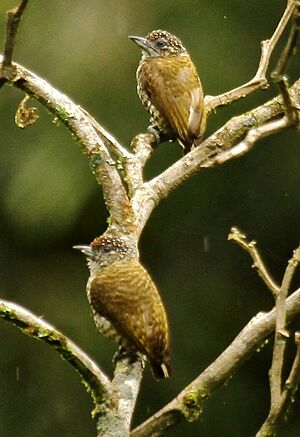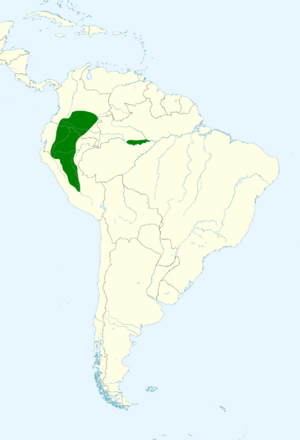Lafresnaye's piculet facts for kids
Quick facts for kids Lafresnaye's piculet |
|
|---|---|
 |
|
| Conservation status | |
| Scientific classification | |
| Genus: |
Picumnus
|
| Species: |
lafresnayi
|
 |
|
The Lafresnaye's piculet (Picumnus lafresnayi) is a small bird that belongs to the woodpecker family, Picidae. It's part of the Picumninae group, which are often called piculets. You can find this bird in countries like Brazil, Colombia, Ecuador, and Peru.
Contents
About the Lafresnaye's Piculet Family
Birds are grouped into families and species based on how they are related. This is called taxonomy. The Lafresnaye's piculet has four different types, called subspecies. They are:
- P. l. lafresnayi (discovered by Malherbe in 1862)
- P. l. punctifrons (discovered by Taczanowski in 1886)
- P. l. taczanowskii (discovered by Domaniewski in 1925)
- P. l. pusillus (discovered by Pinto in 1936)
For a while, the Lafresnaye's piculet was thought to be a type of bar-breasted piculet. Also, the P. l. punctifrons subspecies was once considered its own separate species. Scientists now think the Orinoco piculet is closely related to the Lafresnaye's piculet. They form a "superspecies," meaning they are very similar and share a common ancestor.
What Does the Lafresnaye's Piculet Look Like?
This tiny bird is about 9 to 10 centimeters (3.5 to 3.9 inches) long. It weighs around 9 to 10 grams (0.32 to 0.35 ounces), which is about the same as a few paper clips!
Male Lafresnaye's piculets have a dark olive-brown cap on their head. They have red spots on their forehead and whitish spots on the rest of their head. Their face is grayish with brown streaks, and they have a pale stripe behind their eye. Their back is dark green or brownish-green with yellowish-green stripes. Their tail is blackish, with white on the inner feathers and white tips on the outer ones. Their chin and throat are whitish with narrow black marks. Their belly is pale yellowish-white with wide black stripes.
Female Lafresnaye's piculets look very similar to males. The main difference is that females have whitish spots all over their head, not just on the back part. Young piculets look like adults but are a bit duller in color. Their upper parts are greener, and the stripes on their belly are less even.
The other three subspecies of Lafresnaye's piculet have yellow-orange spots on their forehead instead of red ones. For example, P. l. punctifrons has a darker face and thinner stripes on its belly. P. l. taczanowskii has a blacker head and wider, more uneven stripes. P. l. pusillus has a slightly reddish tint on its back and narrow dark stripes on its belly.
Where Does the Lafresnaye's Piculet Live?
Each subspecies of Lafresnaye's piculet lives in a slightly different area:
- P. l. lafresnayi lives in southeastern Colombia, eastern Ecuador, and down to Peru's San Martín area.
- P. l. punctifrons is found in northern Peru's Amazonas Department.
- P. l. taczanowskii lives in northeastern and north-central Peru. This includes areas between the Huánuco and Ayacucho departments.
- P. l. pusillus is found in north-central Brazil. It lives along the middle Amazon River, stretching east to the Rio Negro.
This piculet likes to live in the edges and clearings of damp, old forests. It also lives in secondary forest, which is forest that has grown back after being cut down. It usually lives at elevations up to 1,400 meters (4,600 feet). Sometimes, in Ecuador, it can be found as high as 1,800 meters (5,900 feet).
Lafresnaye's Piculet Behavior
Movement and Daily Life
Lafresnaye's piculets stay in the same area all year round. They do not migrate to different places.
What Does the Lafresnaye's Piculet Eat?
This piculet finds its food in the lower and middle parts of the forest. It mainly eats termites and probably other small insects too. It often joins groups of different bird species that are foraging together. This helps them find more food and stay safe.
Reproduction and Family Life
Lafresnaye's piculets seem to breed between July and November. Not many of their nests have been found. One known nest was in a hole in a shrub, about 3 meters (10 feet) above the ground. It contained two eggs. Both the male and female piculets help take care of the young birds. Scientists don't yet know how long the eggs take to hatch or how long it takes for the young birds to leave the nest.
How Does the Lafresnaye's Piculet Communicate?
Lafresnaye's piculets are not very noisy birds. However, they do sometimes make a high-pitched sound. It can be described as a "tseeyt, tsit" or a very high "see-see."
Status of the Lafresnaye's Piculet
The IUCN (International Union for Conservation of Nature) has listed the Lafresnaye's piculet as a species of "Least Concern." This means it is not currently considered to be in danger of extinction. It lives across a large area, but its total population size is not known. Scientists believe the number of these birds might be going down. There are no immediate big threats to this bird right now. It is considered "uncommon to fairly common" in Ecuador but rare in Peru.


